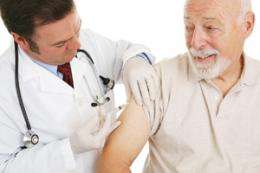Although a vaccine to prevent shingles has been available since 2006, less than 7 percent of U.S. seniors -- the demographic most frequently affected by the disease -- chose to receive the vaccination as of 2008, finds a new study from the Centers for Disease Control and Prevention (CDC).
The vaccine reduces the risk of getting shingles by half and the risk of developing painful complications by two-thirds, according to Gary Euler, study co-author. Since the chance of contracting shingles increases with age and especially is high by age 80, when seniors are frail, he believes the value of the vaccine is incontestable.
Specifically, the vaccine protects against the herpes zoster virus, which causes chicken pox at first infection. The body never rids itself of the virus and it can show up again decades later as shingles. Symptoms include headache, fever and tingling or throbbing accompanied by jabs of stabbing pain called post-herpetic neuralgia (PHN), followed by a skin rash and blisters.
Up to 10 in every thousand seniors develop shingles every year. Without the vaccination, 10 percent to 14 percent of them will suffer from neuralgia.
In the new study appearing online and in the February 2011 issue of the American Journal of Preventive Medicine, researchers found that estimated coverage levels were low among all seniors and lowest among minority groups. Surprisingly, 95 percent of younger seniors had missed at least one opportunity to be vaccinated, even though they had seen their physician at least once, been hospitalized or visited an emergency department that year. The people most likely to have received vaccinations were older, white, female seniors who were more highly educated and who had received a flu shot.
From the results of an earlier study, the researchers can see that uptake is growing, but at a snail’s pace. The study authors gave possible reasons: While most insurance and Medicare plans cover the cost of vaccination, other costs might be out-of-pocket and upfront. Physicians could be reluctant to recommend the vaccine because of this cost burden, especially if the patient has no insurance.
A downside exists for the physicians, too. Euler, an epidemiologist with the CDC’s National Center for Immunization and Respiratory Diseases, said that the vaccine must remain frozen until the last minute, which presents an added burden on two counts. First, there is a time lapse if the physician writes a prescription for the patient to buy the vaccine at a pharmacy and bring it back to the office to have it administered. Second, if a physician writes a prescription for the patient to receive the vaccine at the pharmacy, patients often do not make that additional trip.
Despite these drawbacks, Euler strongly recommends that seniors receive vaccinations for shingles.
“Most patients who know what PHN is like would absolutely agree,” Euler said. “And in terms of cost savings for medical attention and medicine on a population-wide basis, so would most economists.”
More information: Liu P-j, Euler GL, Harpaz R. Herpes zoster vaccination among adults aged 60 years and over, in the U.S., 2008. Am J Prev Med 40(2), 2011.
Provided by Health Behavior News Service


















